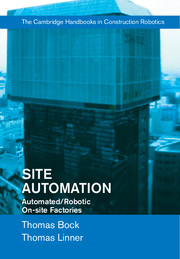Book contents
- Frontmatter
- Contents
- Acknowledgements
- Glossary
- 1 Integrated Automated/Robotic On-site Factories
- 2 Analysis and Categorization: Construction pages 8 to 144
- 2 Analysis and Categorization: Construction pages 145 to 256
- 3 Analysis and Categorization: Deconstruction
- 4 Conclusion: Discrepancy between Technical Capability and Efficiency
- References
- Index
2 - Analysis and Categorization: Construction pages 8 to 144
Published online by Cambridge University Press: 05 April 2016
- Frontmatter
- Contents
- Acknowledgements
- Glossary
- 1 Integrated Automated/Robotic On-site Factories
- 2 Analysis and Categorization: Construction pages 8 to 144
- 2 Analysis and Categorization: Construction pages 145 to 256
- 3 Analysis and Categorization: Deconstruction
- 4 Conclusion: Discrepancy between Technical Capability and Efficiency
- References
- Index
Summary
Integrated automated construction sites can be categorized according to various features or characteristics, such as general working directions, logistics strategies, climbing mechanisms, or configurations of the site factories. It is also possible to characterize them according to manufacturing views (organizational view, product variation view, order-oriented view, or location-oriented view; for further information, see Volume 1). Furthermore, a categorization could also be based on the main building materials processed (steel-based components, concrete-based components). However, the general working direction and thus the location and workflow orientation of the factory and the location of the majority of work activities play a major role in manufacturing of buildings and determine logistics strategies and factory configurations (see Volume 1). As buildings are complex and large products (similar to aircrafts or tunnels; see Volume 1) that require a final assembly on the fixed, final site (see Volume 1), the orientation of the building and thus the location and working direction on-site determine the general organizational setting and thus the logistics strategy, climbing system (CS), and factory configuration. In this chapter a combined location and working-direction–oriented view is used as the basis for categorization.
A location and working-direction–oriented view on manufacturing considers the location or environment in which the product is manufactured as well as its geometrical characteristics. Usually, a product can be manufactured off-site in a factory some distance from the final location to which the finished product is finally shipped and used, as the product in its final state is still a mobile entity (a kind of large module) for which a transport infrastructure exists. Most complex products, such as ships, automobiles, aircraft, and most consumer products can be produced that way. It is no problem to pack and ship them.
However, products such as buildings, towers, bridges, and so forth have to be produced on-site at the location at which they will finally be used and they simply cannot be moved or shipped as a complete entity. High-level component manufacturers or unit manufacturers such as Sekisui Heim circumvent the need for on-site production by splitting up a building into three-dimensional high-level modules that are then produced and finished in the factory so that only minor work (in the case of Sekisui Heim 15–20%; presented in detail in Volume 2) has to be done on the construction site.
- Type
- Chapter
- Information
- Site AutomationAutomated/Robotic On-Site Factories, pp. 8 - 144Publisher: Cambridge University PressPrint publication year: 2016



